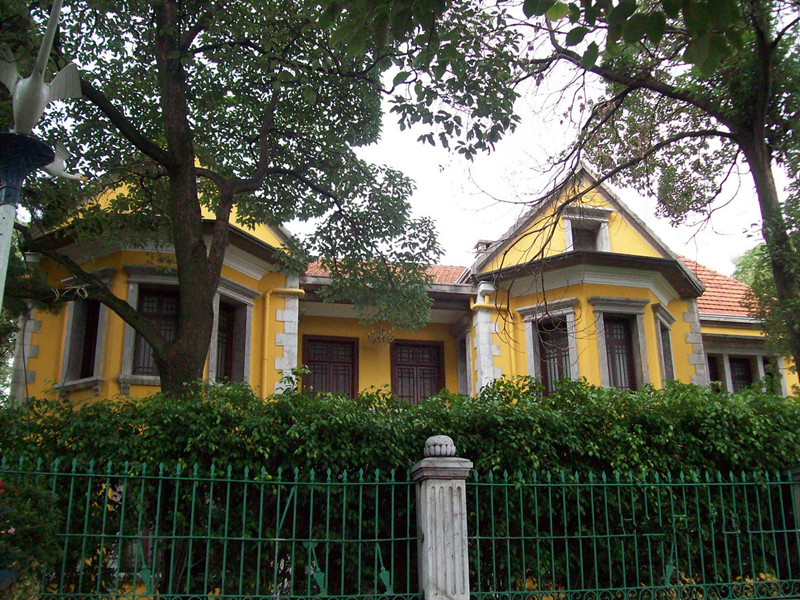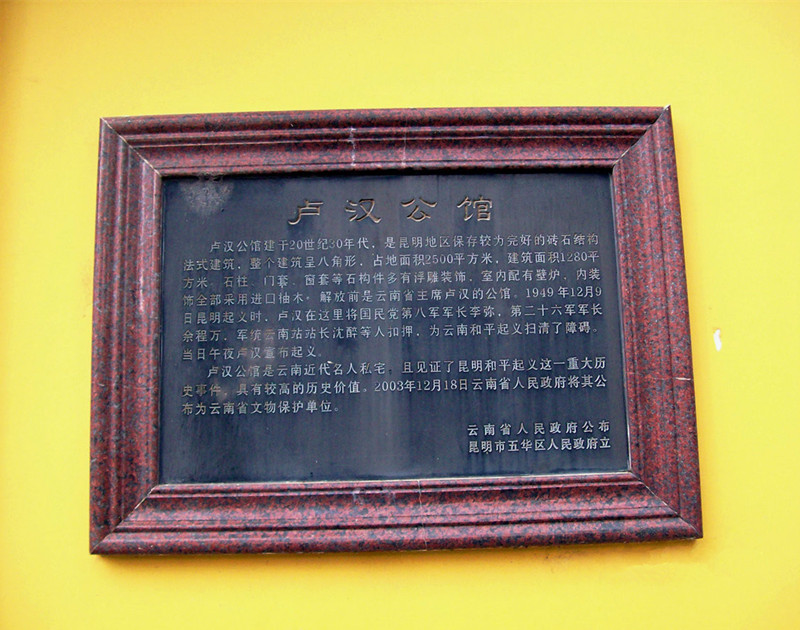
Former Residence of Luhan in Kunming
The Former Residence of Luhan (昆明卢氏公馆), originally named Luhan Mansion, is located at 4 Cuihu South Road, Cuihu Community, Huashan Street Office, Wuhua District, Kunming City, Yunnan Province, China. It was built in the 19th year of the Republic of China (1930).
Overview
The residence consists of two parts: the New Mansion and the Old Mansion. The total area covers 5,600 square meters, with a building area of 1,500 square meters. The structure is two stories high, featuring brick walls, wooden frameworks, and some reinforced concrete components. The steep, hard-slope roof has triangular gables, and the building exhibits a sophisticated geometric composition in its wall and window designs, including protruding bay windows on the east and west sides. The architectural style of the Old Mansion is primarily French, showcasing a typical French villa design. The site retains its original layout, including Luhan Mansion’s Old Mansion, New Mansion, water tower, enclosing wall, trees, and surrounding spaces, giving it significant artistic value.
In 2003, the Former Residence of Luhan was recognized as a cultural heritage site by the Yunnan Provincial People’s Government. On October 7, 2019, it was announced as one of the eighth batch of national key cultural relic protection units by the State Council of the People’s Republic of China.
Location: 4 Cuihu South Road, Cuihu Community, Huashan Street Office, Wuhua District, Kunming City, Yunnan Province, China
Era: Established in 1930
Area: 5,600 m²
Protection Level: Eighth batch of national key cultural relic protection units
Registration Number: 8-0717-5-201
Approving Authority: State Council of the People’s Republic of China
Historical Development
The Former Residence of Luhan was constructed in 1930. In the late period of the 29th year of the Republic of China (1940), Luhan built a new two-story Western-style building adjacent to the mansion. In 2019, according to the minutes from the April 29, 2019 meeting of the Yunnan Provincial Office Administration Bureau, the Wuhua District Government prepared for an exhibition titled “Yunnan Uprising” in the Old Mansion. This exhibition opened to the public for free on July 1 of the same year.
Architectural Layout
The Former Residence of Luhan consists of two parts: the New Mansion and the Old Mansion, covering a total area of 5,600 square meters and a building area of 1,500 square meters. The buildings are connected vertically, with the northern section shaped like a “工” (work) and the southern section shaped like a “一” (one), resulting in a total of five roofs and sixteen wall facades, creating a rich sense of layering. The Old Mansion primarily adopts French architectural styles and is characterized by typical French villa design. The New Mansion is finely crafted and represents high architectural art, typical of French villa architecture.
Main Buildings
Old Mansion
The Old Mansion of the Former Residence of Luhan is a French-style building. It has two stories, featuring brick walls, wooden frameworks, and some reinforced concrete structures. The roof has a steep slope with triangular gables. The wall surfaces and windows are carefully designed with geometric compositions, with protruding bay windows on the east and west sides that are simple yet varied. The exterior has red tiles and white walls, complemented by gray trim lines, creating a harmonious and beautiful appearance. The interior decoration is elegant and luxurious, with a fireplace in the living room and floor-to-ceiling doors and windows connecting the main and guest bedrooms with balconies.
New Mansion
Luhan constructed the New Mansion next to the Old Mansion. Its main entrance originally faced Qinglian Street and is internally connected to the Old Mansion. The New Mansion’s architectural style adopts a Soviet-style design, featuring the layout typical of Soviet residential buildings.
Cultural Significance
The Former Residence of Luhan is a private residence of a famous modern figure in Yunnan and has witnessed significant historical events during the Kunming Uprising, giving it high historical value. The Old Mansion, New Mansion, water tower, enclosing wall, trees, and surrounding space have all been well-preserved, providing significant architectural artistic value.
Notable Figures
Luhan (卢汉, 1895-1974), originally named Banghan, was a member of the Yi ethnic group from Yanshan, Zhaotong, Yunnan. He graduated from the Yunnan Military Academy. Over his career, he held various positions, including brigade leader, division commander, and financial director of the Yunnan provincial government. During the Second Sino-Japanese War, he served as commander of the 60th Army and other significant military roles. After Japan’s surrender in 1945, he was ordered to lead his troops to Vietnam for the surrender process. In December of the same year, he succeeded Long Yun as the provincial government chairman. After the founding of the People’s Republic of China, he held several important positions, including director of the Yunnan Provincial Military and Political Committee and member of the Standing Committee of the National People’s Congress.
Kunming Uprising
On December 9, 1949, during the Kunming Uprising, Luhan detained several key Nationalist leaders, including General Li Mi of the Eighth Army, General Yu Chengwan of the 26th Army, and Shen Zui, head of the military intelligence in Yunnan, at the Former Residence of Luhan. At midnight, he declared the uprising.
Protection Measures
In 2003, the Former Residence of Luhan was recognized as a cultural heritage site by the Yunnan Provincial People’s Government. On October 7, 2019, it was announced as one of the eighth batch of national key cultural relic protection units by the State Council of the People’s Republic of China.
Tourism Information
Location: The Former Residence of Luhan is located at 4 Cuihu South Road, Cuihu Community, Huashan Street Office, Wuhua District, Kunming City, Yunnan Province, China.
Transportation: You can reach the Former Residence of Luhan by taking a bus to the Huashan Street area in Wuhua District, Kunming.



 7 Days GolfingTour
7 Days GolfingTour
 8 Days Group Tour
8 Days Group Tour
 8 Days Yunnan Tour
8 Days Yunnan Tour
 7 Days Shangri La Hiking
7 Days Shangri La Hiking
 11 Days Yunnan Tour
11 Days Yunnan Tour
 6 Days Yuanyang Terraces
6 Days Yuanyang Terraces
 11 Days Yunnan Tour
11 Days Yunnan Tour
 8 Days South Yunnan
8 Days South Yunnan
 7 Days Tea Tour
7 Days Tea Tour
 8 Days Muslim Tour
8 Days Muslim Tour
 12 Days Self-Driving
12 Days Self-Driving
 4 Days Haba Climbing
4 Days Haba Climbing
 Tiger Leaping Gorge
Tiger Leaping Gorge
 Stone Forest
Stone Forest
 Yunnan-Tibet
Yunnan-Tibet
 Hani Rice Terraces
Hani Rice Terraces
 Kunming
Kunming
 Lijiang
Lijiang
 Shangri-la
Shangri-la
 Dali
Dali
 XishuangBanna
XishuangBanna
 Honghe
Honghe
 Kunming
Kunming
 Lijiang
Lijiang
 Shangri-la
Shangri-la
 Yuanyang Rice Terraces
Yuanyang Rice Terraces
 Nujiang
Nujiang
 XishuangBanna
XishuangBanna
 Spring City Golf
Spring City Golf
 Snow Mountain Golf
Snow Mountain Golf
 Stone Mountain Golf
Stone Mountain Golf


















